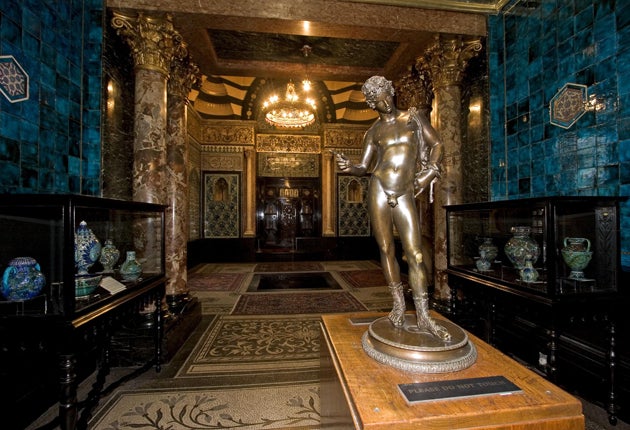Leighton House Museum, Holland Park, London
Glorious Orientalism – but it stops at the bedroom door

Your support helps us to tell the story
From reproductive rights to climate change to Big Tech, The Independent is on the ground when the story is developing. Whether it's investigating the financials of Elon Musk's pro-Trump PAC or producing our latest documentary, 'The A Word', which shines a light on the American women fighting for reproductive rights, we know how important it is to parse out the facts from the messaging.
At such a critical moment in US history, we need reporters on the ground. Your donation allows us to keep sending journalists to speak to both sides of the story.
The Independent is trusted by Americans across the entire political spectrum. And unlike many other quality news outlets, we choose not to lock Americans out of our reporting and analysis with paywalls. We believe quality journalism should be available to everyone, paid for by those who can afford it.
Your support makes all the difference.Did Frederic Leighton actually live in Leighton House? This isn't a question calculated to infuriate the rate-payers of Kensington and Chelsea, who have just funded the £1.6m refurbishment of the brick-built villa in London W14 – and presumably did so on the understanding that it was the gaff of one of Victorian England's finest (and hairiest) artists.
It's just that walking through its gilded rooms, watching the light move through its newly polished stained-glass windows, eyeballing the stuffed peacock that perches by the ebonised banisters of its central staircase, it's hard to imagine that this building was the scene of any activity that might accurately be described as domestic.
Frederic Leighton liked painting soft-eyed Arab boys in classical settings and firmed-jawed women asleep in a sea of their own hair. He may have liked doing other things with them, too, but he burned his private papers and now we'll never know. To step inside his home is to enter a fantasia of late-Victorian Orientalism, an exotic world untroubled by Edward Said's idea that there is probably something questionable about a single white gentleman who surrounds himself with feathers, silks, Islamic tiling and sculptures of naked Greek athletes wrestling pythons.
Leighton's friend George Aitchison built the first phase of the house in 1864, and continued building until its owner was carried out in a box three decades later. The great triumph of this work is the Arab Hall, a two-storey internal courtyard armoured with a thousand tiles imported from Syria, Turkey and Persia, among which is set a box-shaped Mashrabiya window transplanted from a building in Cairo, and a mosaic fountain that splishes with the same gentle rhythm as one might have heard in the Leicester Square gents' during its Victorian heyday. It may be the most spectacular room in London, but it's hard to imagine quite what you'd do in it, except recite Dante, or inhale laudanum from a silk handkerchief, or teach your pet macaque how to smoke a cheroot.
The great revelation of this refurbishment, however, is that for Leighton, Orientalism stopped at the bedroom door. The public areas of the house are decorated in what might be regarded as a boudoir style – but the boudoir itself is almost comically sober: dark green floral William Morris wallpaper; a modest single bed, over which is suspended a bare bulb strung from an ugly electrical wire; a narrow door separating Leighton's water closet from the rest of the room. The effect is to propel you towards the conclusion that Leighton House has always been a kind of museum – a showcase for the work and the aesthetic ideas of its owner.
In Leighton's lifetime, it was already known as "the Private Palace of Art". Parties of children walked around the ground floor and examined his collection of tiles. Potential clients toured the studio on the upper level, and wondered what it might be like to have a Leighton on their drawing-room wall.
So what occurred on the threshold between these two worlds – between the high oriental and the suburban occidental? I suspect Leighton may have crossed this borderline like a weary drag queen who, after a long night under the glitterball, has finally earned the right to unpeel her high heels and false lashes. You can imagine him returning to his little room each night, shaking off his satin peignoir, tossing his tasselled skull-cap on the peruke stand, shutting the door on the Orientalist razzle-dazzle of his professional life, and breathing a grateful sigh of relief. Now we can do the same.
Leighton House Museum reopens 3 April (020-7602 3316)
Join our commenting forum
Join thought-provoking conversations, follow other Independent readers and see their replies
Comments